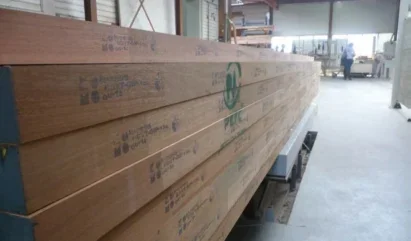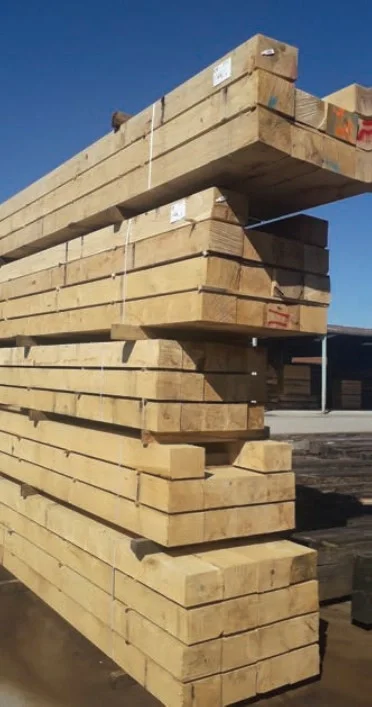
“Middle of the road” is how one trader summed up the UK hardwood market this year, echoing the sentiment of others in the business.
“Through the year it’s just been pretty flat,” said an importer. “We set our budget, and we’ve hit the numbers each month, but we’re just getting over the line. We’ve had busy weeks, then quiet ones. There’s been no pattern to it.”
The state of the market was mainly attributed to the slow-moving UK economy. The latest British Chambers of Commerce outlook forecasts a slight improvement from its previous analysis, but predicts 2024 GDP growth of just 1.1%, with government spending the main driver. It expects household consumption to increase in 2025, but sees GDP growth only hovering around 1%, before rising to 1.1% in 2026.
However, one importer-distributor said after a slow summer they had seen “some improvement” in volumes in September, although margins remain under pressure.

Another importer-distributor agreed June to August was quieter than the usual summer lull. But they too reported an upturn in September into October. “Merchant activity has increased, and we seem to be heading back to where we want to be,” they said. “Whether the budget reinforces the improvement or slams the brakes back on remains to be seen.”
There was general agreement that it’s too early to say what the impact of the budget will be.
“We won’t see the outcomes until the medium to longer term and the budget commentary is very varied,” said an importerdistributor. “The hospitality sector is saying increased NI payments will hit their ability to invest in refurbishment, but the government is devoting an extra £1.4bn on school rebuilds. The hike in the minimum wage, fuel duty freeze and pension triple lock, in combination with lower interest and inflation rates is also predicted to underpin consumer spending.”
Government promises to boost house building to over 300,0000 homes annually were expected by an importer to impact as early as next year.
“Although it will take longer to feed through to second fix work where most hardwood is used, we expect the government’s pledge to help improve industry and consumer confidence, lifting house building and repair maintenance and improvement work after some pretty depressed times,” they said.
This view tallies with forecasts from the Construction Products Association in its autumn report. After an “extremely challenging 18 months” for the sector, it predicts UK construction output to be 2.9% lower this year, before growing 2.5% next year, with private house building up 8% and RMI 3%.
Brighter spots in the hardwood market more recently, said suppliers canvassed, include some areas of joinery.
“Demand from staircase and window makers has picked up,” said an importerdistributor. “Hopefully that’s an early sign of recovery in home improvement.”
Another importer-distributor reported more activity in the door sector. “It seems to be driven by commercial and hospital builds,” they said. “From framing to door blanks, we’ve been getting busier.”
Another point of general agreement in the sector is that there is plenty of hardwood in the market.
“Against the background of generally flat trade for 18 months, there’s a lot of wood on the ground, and overall stock levels are keeping margins tight,” said an importer.
Looking at sources of supply, industrial relations at US ports are causing concern.
“The dockers strike in September may have been called off, but it’s a temporary agreement and it’s back to the negotiating table in January, so the American hardwood supply chain remains fragile,” said one importer.
Against the backdrop of continuing robust US domestic hardwood demand, importers also say it’s a seller’s market.
“Getting what you want in terms of grade, dimension and so on is challenging,” said an importer. “You have to hunt it down and you’ll still probably have to buy half a container of what you don’t want to get the half you do.”
In terms of price, white oak is reported firm, with tulipwood/poplar increasing and ash stable. And higher-grade walnut is increasingly difficult to find.
Several interviewees reported further growth in interest in red oak.
“Obviously the 40% price differential with white oak is a contributing factor,” said an importer. “But end-user customers who start using it, seem to stick with it. We’re selling red oak every week now, after hardly doing any for 20 years.”
But again, tracking down the right quality is reported to be demanding.
“There isn’t a mountain of red oak you can just tap into,” said an importer. “You can’t just take your pick at the moment in terms of the grade, length or colour.”
An importer-distributor reported growth in red oak demand in joinery, notably staircase manufacture. “But they’re very demanding on spec,” they said. “The colour is the most onerous consideration and the question for suppliers is, while they can manage consistency on one load, can they do it for 12?”
On European hardwood, oak and beech supply are reported to be stable, prices likewise.
“Availability is there,” said an importerdistributor. “On oak, if I need to buy 10 loads, I know I can, and the stronger pound has helped us on price.”
At the same time, an importer said there was no “sign of wider weakness on price” in European oak. “Availability is good and if you want to negotiate a deal, suppliers might talk about it. But they’re holding their nerve. They’re keen to sell but not dumping lumber by any means.”
As far as Africa is concerned, an EU-based supplier to the UK reports shorter delivery times, except on iroko, doussie and zebrano.
Sapele prices were reported to have been down marginally at the start of the year, but stable since.
However, one importer-distributor said they had struggled to sell sapele over the last year due to an increase in uncertified timber on the market at prices they couldn’t match. “But we’re taking a strong stance. We decided 18 months ago to buy the majority of our sapele from one FSC-certified shipper supplying a quality product.”
But another importer reported a contrasting experience, saying the “benefits in the market of offering FSC-certified African hardwood are more tangible than before”.
“Maybe it’s because it has become better known, with more major African concessions now offering it,” they said, adding that their premium on FSC sapele was 10%.
UK importers report iroko being increasingly difficult to find in sufficient quantities. Prices were also pushed up by lack of drying capacity, although they have now plateaued.
Certified South American red grandis is reported to be a good solid business. But trade with Asia, notably in meranti, is said to have been slow.
“It hasn’t been made easier by fluctuating freight rates, accentuated by the Suez crisis,” said an importer. “Container prices from Asia came down from the heights of the pandemic to around US$2,500 but rose again recently to US$5,000-6,000. They’ve come off that peak, but some expect another rise in January.”
Importers were agreed that the deferment of the introduction of the EU Deforestation Regulation (EUDR) by 12 months is a positive.
“Inevitably the UK will be impacted by the Regulation. Most UK timber imports are from the EU, and our customers sell their products there and not only will timber and wood products placed on the EU market be covered, but also its exports,” said an importer. “It will all have to satisfy the EUDR’s requirements for due diligence to ensure it’s not implicated in deforestation and for geo co-ordinates of origin. It’s a complex ask, and the EU accepts it needs to provide more guidance and clarity. Having another year will allow for that and for businesses to prepare.”
A leading international trader and distributor said they would take the opportunity to work with suppliers to ensure they can provide the compliance information required.
“The online platform for uploading EUDR due diligence and geolocation information goes live in November, enabling us to act to suppliers as if the Regulation is in place,” they said. “Together we can make this work.”
Looking forward to 2025, the view of one importer reflected the consensus.
“Success will be down to maintaining customer service, while strictly managing timber inflows,” they said.





